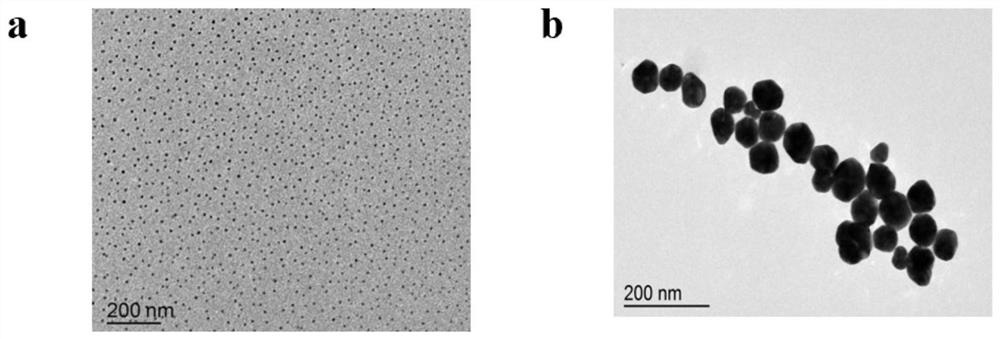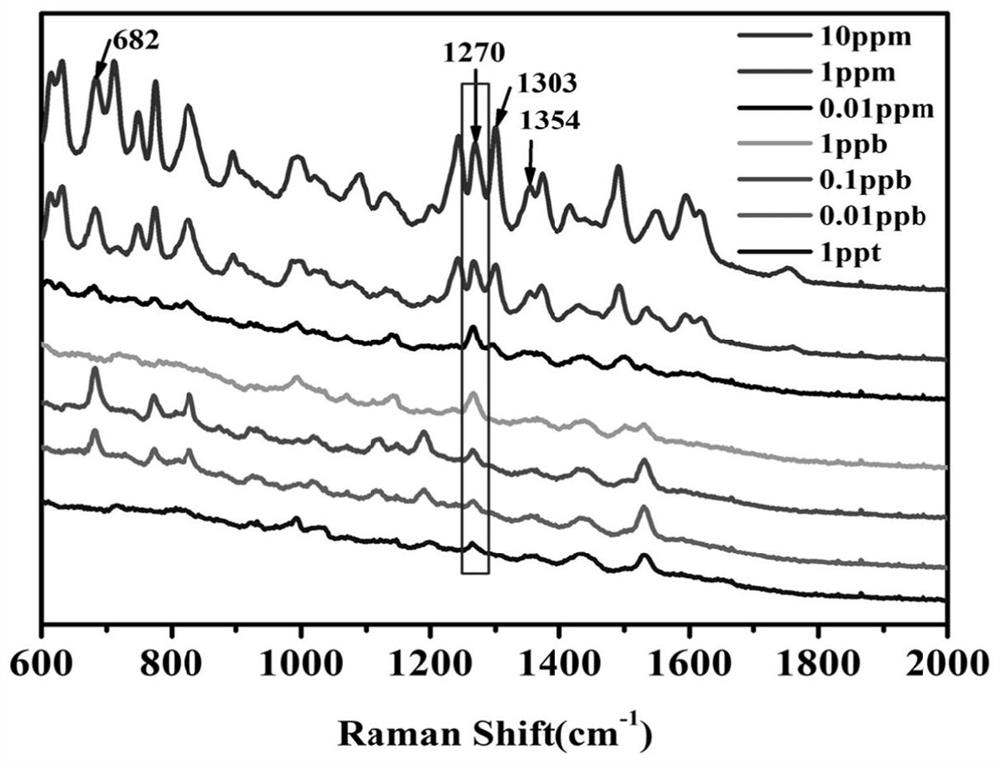Method for detecting various mycotoxins based on Raman spectrum of gold nanoparticles
A mycotoxin and surface-enhanced Raman technology, applied in Raman scattering, material excitation analysis, etc., can solve the problems of ultra-sensitive Raman spectrum detection, such as complex detection, time-consuming and labor-intensive, application limitations, etc., to achieve low cost, improve application characteristics, The effect of improving specificity and precision
- Summary
- Abstract
- Description
- Claims
- Application Information
AI Technical Summary
Problems solved by technology
Method used
Image
Examples
Embodiment 1
[0048] A preparation method of a surface-enhanced Raman detection substrate, comprising the following steps:
[0049] (1) 1 mL of trisodium citrate (20 mg / mL) was added to 98.9 mL of distilled water, heated to boiling in boiling water, and 100 μL of 250 mM tetrachloroauric acid solution was rapidly added under vigorous stirring and kept boiling for 3 min to obtain particle size Smaller gold nanoparticle solutions;
[0050] (2) placing the gold nanoparticles obtained in step (1) in a refrigerator at 4° C. for 24 hours to obtain a gold seed solution;
[0051] (3) at room temperature, take 1 mL of the gold seed solution obtained in step (2) and add it to 40 mL of distilled water, add 400 μL of 1w / w% trisodium citrate solution and 400 μL of 1w / w% hydroxylamine hydrochloride solution in turn, and react with rapid stirring at constant temperature for 6 min; 80 μL of tetrachloroauric acid solution (240.44 mM) was quickly added thereto to obtain a surface-enhanced Raman detection sub...
Embodiment 2
[0054] A preparation method of a surface-enhanced Raman detection substrate, comprising the following steps:
[0055] (1) 1 mL of trisodium citrate (25 mg / mL) was added to 98.9 mL of distilled water, heated to boiling in boiling water, rapidly added 100 μL of 250 mM tetrachloroauric acid solution under vigorous stirring and kept boiling for 4 min to obtain particle size Smaller gold nanoparticle solutions;
[0056] (2) placing the gold nanoparticles obtained in step (1) in a refrigerator at 4° C. for 24 hours to obtain a gold seed solution;
[0057] (3) At room temperature, 1 mL of the gold seed solution obtained in step (2) was added to 37.4 mL of distilled water, followed by adding 400 μL 1w / w% trisodium citrate solution and 400 μL 1w / w% hydroxylamine hydrochloride solution, and the reaction was stirred rapidly at a constant temperature 5 min; 80 μL of tetrachloroauric acid solution (240.44 mM) was quickly added thereto to obtain a surface-enhanced Raman detection substrate...
Embodiment 3
[0059] A preparation method of a surface-enhanced Raman detection substrate, comprising the following steps:
[0060] (1) 1 mL of trisodium citrate (30 mg / mL) was added to 98.9 mL of distilled water, heated to boiling in boiling water, and 100 μL of 250 mM tetrachloroauric acid solution was rapidly added under vigorous stirring and kept boiling for 17 min to obtain a particle size Smaller gold nanoparticle solutions;
[0061] (2) placing the gold nanoparticles obtained in step (1) in a refrigerator at 4° C. for 24 hours to obtain a gold seed solution;
[0062] (3) At room temperature, take 1 mL of the gold seed solution obtained in step (2) and add it to 38 mL of distilled water, add 400 μL of 1.5w / w% trisodium citrate solution and 400 μL of 1.5w / w% hydroxylamine hydrochloride solution in turn, and stir rapidly at a constant temperature The reaction was carried out for 5 min; 80 μL of tetrachloroauric acid solution (240.44 mM) was quickly added thereto to obtain a surface-enh...
PUM
| Property | Measurement | Unit |
|---|---|---|
| Particle size | aaaaa | aaaaa |
| Particle size | aaaaa | aaaaa |
Abstract
Description
Claims
Application Information
 Login to View More
Login to View More - R&D
- Intellectual Property
- Life Sciences
- Materials
- Tech Scout
- Unparalleled Data Quality
- Higher Quality Content
- 60% Fewer Hallucinations
Browse by: Latest US Patents, China's latest patents, Technical Efficacy Thesaurus, Application Domain, Technology Topic, Popular Technical Reports.
© 2025 PatSnap. All rights reserved.Legal|Privacy policy|Modern Slavery Act Transparency Statement|Sitemap|About US| Contact US: help@patsnap.com



